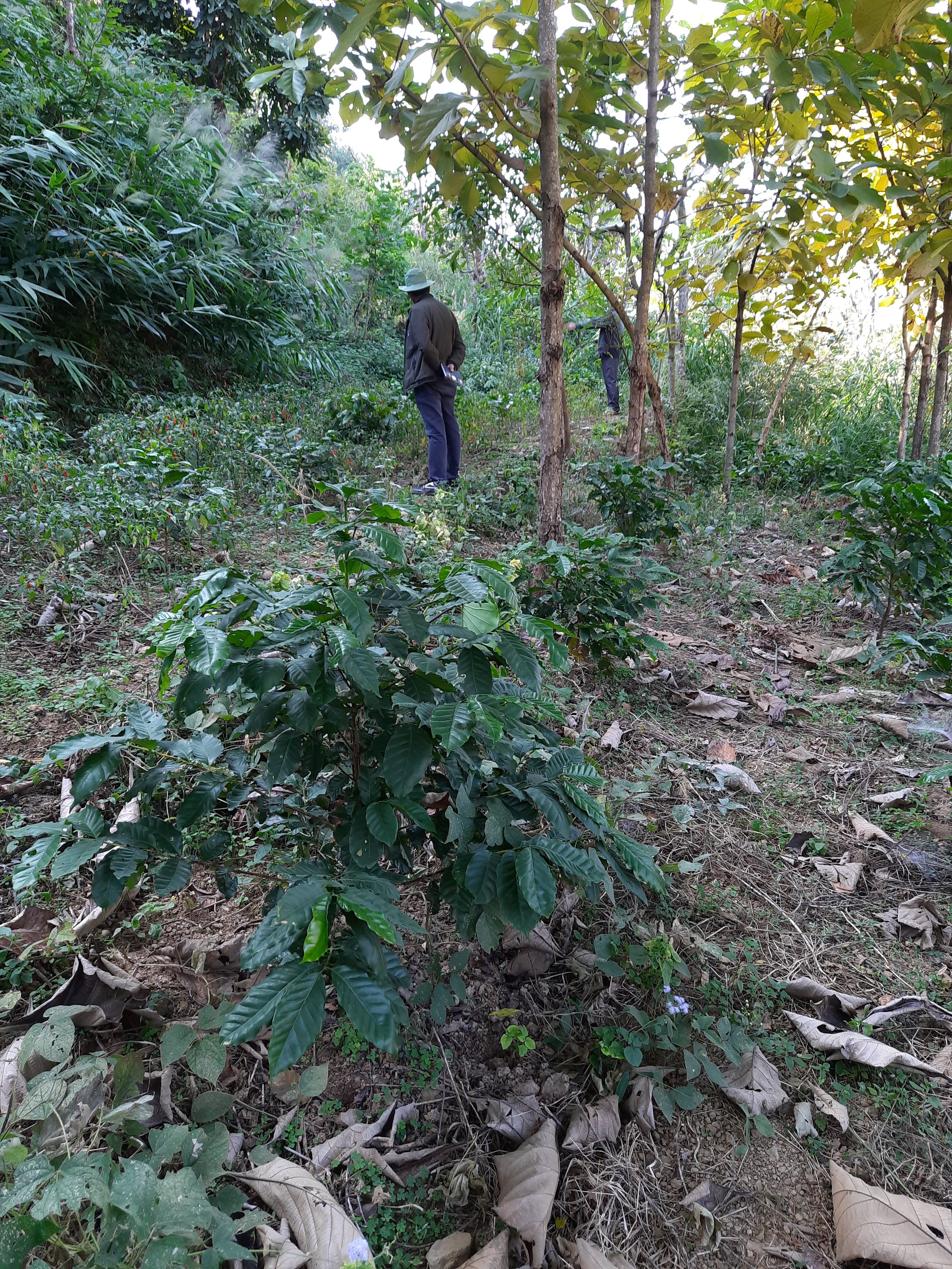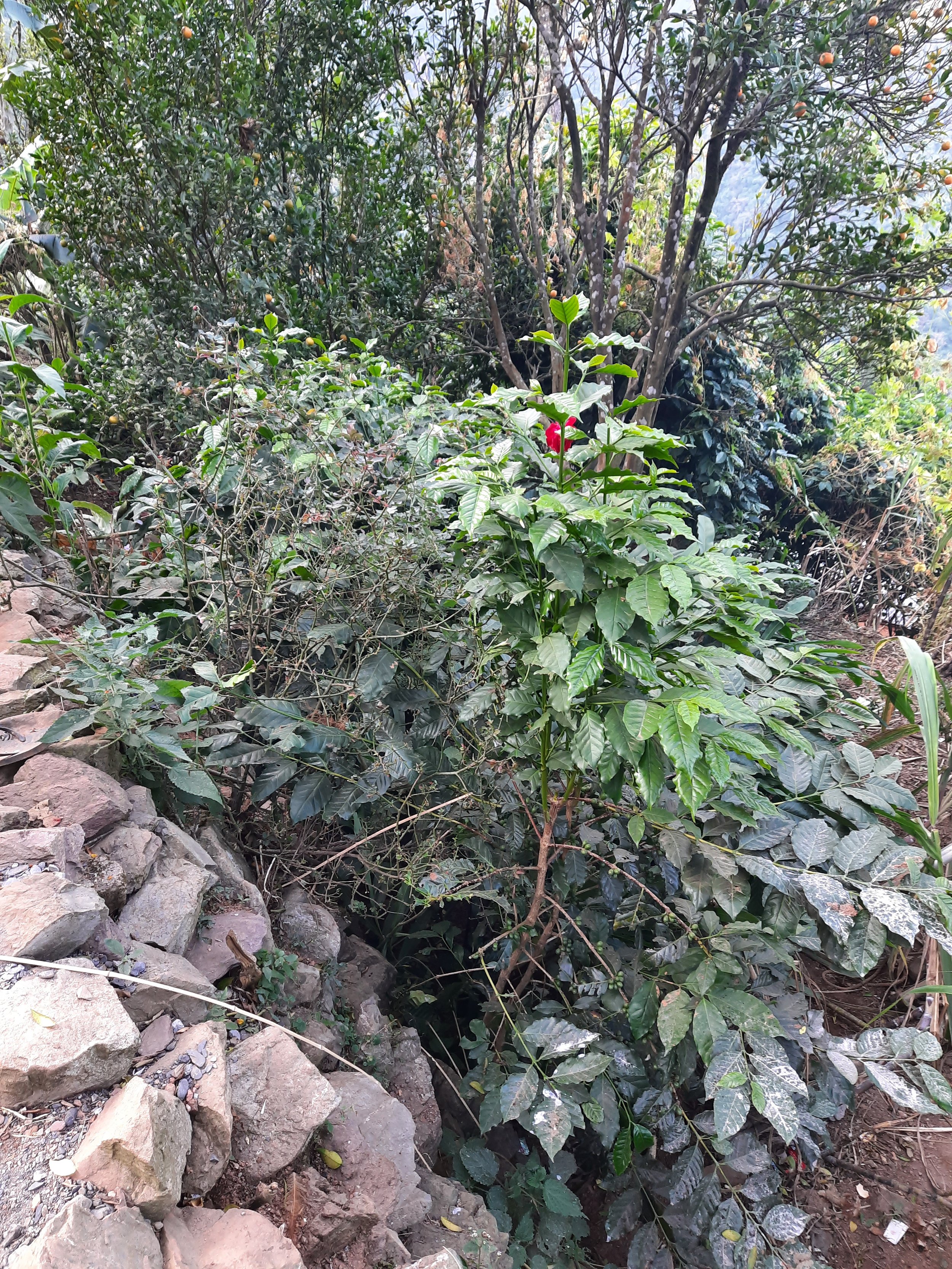TGT’s Nepal based Co-Director, Richard Allen visited our NGO partners, HICODEF in Nawalparasi, south central Nepal, in December 2021. This is the second in a series of photo essays he has created for us on the progress being made on our Layer Farming for Adaptation (LFAP) project.
Episode 2: Monitoring Our LFAP Project – The Coffee Story
History of Coffee in Nepal
As folklore (another word for the internet) has it, coffee was introduced to Nepal by a gentleman called Hari Giri, who bought the coffee into the country in 1939 from the then Myanmar, and first planted it in his backyard in Gulmi District, a central area of Nepal. The coffee grew and produced well, and Hari distributed the cherries and seeds to other impressed and interested farmers.
For decades, the few growers produced the coffee for home use with a few sales through India. As time went by, Gurkha soldiers stationed in various parts of the world, and Nepalese labourers who worked at coffee farms in South India brought in more Arabica coffee, the best quality coffee species and the main type grown in Nepal.
30 years after Hari’s first introduction, the Government, in 1968, imported coffee seeds from India and distributed them to farmers in Gulmi, Palpa and Arghakhanchi Districts. In 1983, the Nepal Coffee Company was established; it purchased dried coffee cherries from producers, and processed it for the domestic market.
Commercial coffee production only started in the 1990s, and has expanded significantly since then. To support the further development of coffee production in the country, the National Tea and Coffee Development Board (NTCDB) was established in June 1993, under the Ministry of Agriculture and Livestock Development, following the adoption of the Tea and Coffee Development Board Act (1992).
Coffee is now grown in some 40 districts, coffee from Nepal is considered by overseas importers as of good, sometimes excellent quality, and worldwide, regional and national demand remains high. The Specialty Coffee Association of America, as one example, now recognizes the coffee produced in Nepal as a high standard coffee. The demand for organic coffee was recognized in the early 2000s, and the great majority of coffee now grown in Nepal is organic.
The National Picture
Even just 15 years ago, folks in Nepal relied almost completely on the dreadful instant stuff, a different drink altogether. Things have changed. Kathmandu is a city of trends – one noticed this driving the kids the short journey to school since 2005: there was one restaurant, then dozens, there was one bicycle shop, then seven, there was one café selling coffee from Nepali beans, now there is one on every street corner and in between – 11 at the last count on the drive to school.
That is Kathmandu – but Nepali coffee cafés are springing up everywhere, in the mountains and hills and now in the terai. The national demand for coffee cannot be met by national production, and the same is true of the international demand for Nepali coffee. Most cafés genuinely sell high quality coffee from Nepal, (although, shhusshhh, there are rumours that one or two companies sell coffee labelled ‘Nepali’ which is in fact made of cheaper beans imported from India). Prices for a cup range quite markedly, from Rs 130 (£0.80) to Rs 450 (£2.75), depending on how the establishment views itself.
Between the altitudes of 800m and 1600m (above sea level), Nepal has many areas in the mid-hills which are very suitable for coffee – it is generally agreed that the best quality coffee comes from areas between 1000m and 1400m, but this is changing as temperatures increase. Only a very small percentage of the estimated 1 million hectares of land well suited to coffee production, is currently planted to coffee – there is plenty of potential.
Expansion of the area under coffee will have significant benefits at all levels, both economically and environmentally. Although identifying accurate data on all matters coffee is difficult as much of it is conflicting even from the same source, it was estimated that some 32,000 farming households were engaged in coffee production in 2017, and annual coffee production over the last few years is in the region of 400 to 500 tonnes of roasted beans, of which around 20% is exported to Germany, Japan, South Korea, the USA, Australia and other European countries.
Some facts and figures according to the National Tea and Coffee Development Board data:
The local demand for domestic coffee stands at between 4,000 to over 7,000 tonnes annually according to various estimates – the latter estimate is over 13 times the national production – I would love to see the base data for this claim, but it is assumed that the demand for instant coffee is included in these overall figures.
To summarize – demand is much bigger than production, demand for Nepali organic coffee is huge in the international market, local demand is let’s say, around 5,000 tonnes, and Nepal produces around 400 to 500 tonnes. Heh, farmers of Nepal, plant coffee on all your waste and unused land!
History of Coffee in the Project Area
Back to Nawalparasi and the Layer Farming for Adaptation Project (LFAP). HICODEF and TGT are just one of many NGOs/INGOs that have tried to boost coffee production over the last few decades. In all the seven LFAP communities, we observe old coffee trees, planted some 15 to 20 years ago, by various I/NGOs and projects – such as NEST (Nucleus for Empowerment through Skill Transfer), which evolved from a United Mission of Nepal programme, based in Pokhara, and an old Action Aid project, which provided coffee trees in Dhoubadi, Lahape, Baseni and Pokhari.
Interestingly, most of these trees were planted for soil erosion control reasons, so little emphasis was placed on production. In Ripaha village (a Phase 1 community), we were told that hundreds were planted but little follow-up was provided, and as the farmers did not know how to harvest and process the cherries into roasted beans, some 80% of the trees were chopped down after five years – which produced fodder for the goats, and firewood for the kitchen.
In Charghare, a Phase 2 village, some 54 fifteen-year-old coffee trees survive – here, we were informed, that those who planted the coffee visited once to plant, and a year later visited again to see if they had survived – “oh yes, they have survived, good” and left, never to be seen again. This is the problem with projects – unless the activities and lessons learnt are strongly absorbed by government programmes, local NGOs or communities, they are a flash in a pan. I hope TGT and HICODEF never operate like this – one advantage in Nepal in recent years, since the federalization process began in 2015, is that working with the local governments, much more influential institutions than in the past, is much more fruitful nowadays as, in most cases, there is a real commitment to development at the local level.
What is the LFAP Project Doing Regarding Coffee
One of the reasons that TGT funded LFAP was the interest shown by farmers in properly managing the old and surviving coffee trees. LFAP Phase 1 thus provided the necessary training, bringing in experienced specialists to coach the farmers on all matters coffee, from planting and nursery management, through care in the field to harvesting, processing and marketing; 2 days of expert training were provided for a total of 91 farmers and 5 trainees (38 male and 58 female) in each of the three Phase 1 communities, Ripaha, Baseni and Lahape. HICODEF also organised a study tour for 9 farmers to an advanced coffee producing area in Kathmandu valley.
The Old Coffee Trees
Photo 1: The mature surviving coffee trees are between 15 and 20 years old. Under the guidance of HICODEF project officer Shukra (on the left), farmers in the three Phase 1 communities were trained on pruning and general management of these older trees, and all of them are now producing cherries and yields have markedly improved. This tree belongs to Dil Bahadur Khamcha, the Chairperson of the Farmer’s the LFAP group in Riphaha.
Photo’s 2 and 3: Another good looking coffee tree with its proud owner in Ripaha, with developing coffee cherries.
Photo 4: In Charghare, a Phase 2 community of some 60 households, of which 48 are members of the new LFAP farmer group, discussions were held with three members of the community on the aspects of coffee production that LFAP will provide training and assistance on. There are an estimated 54 mature coffee trees in Charghare, planted some 15 years ago by the NEST project as a soil erosion control measure, many of them now absorbed into hedgerows at the side of footpaths and agricultural fields. Some of these trees occur at altitudes well below 1000 metres and may not produce best quality coffee as temperatures increase. Landslides are very common in the Charghare area, and more extensive plantations around the village will assist in stabilizing the landscape.
Photo 5: In Dhoubadi, also a Phase 2 community, baseline surveys have been completed and several discussions held with community leaders and farmers on how the project will move forward and what will be provided. During this monitoring visit, discussions were held with the Ward Chairperson, Padam Bahadur Rana (pink right) and Mukte Singh Ale, the Head of the LFAP farmer group (pink left). Dhoubadi is a community of 41 households, 20 of whom are members of the LFAP farmer group, and there are some 133 mature trees, all which need attention in terms of pruning and improved management. Padam has 12 of these older trees on his land, and for the past 2 years has started using the coffee cherries for home use, having only recently learnt the processing technique.
In the four new Phase 2 communities, Shukra, the Project Coordinator, has so far counted 206 mature coffee trees, the majority of them in Dhoubadi.
Nurseries
Coffee nurseries of varying sizes are everywhere in the Phase 1 communities, which reveals the great interest of the farmers in becoming producers – some of these nurseries are in spare areas of polytunnels, others are in the corner of the kitchen garden, or in the shade of a nearby tree. Some are planted in the normal black plastic bags, others are growing directly in the ground, yet further are planted in plastic bags from the ubiquitous junk food, which is a good example of recycling waste.
It was noted however that the coffee seedlings grown directly in the ground were doing significantly better than those in the poly- or plastic bags – presumably and mainly because of water and nutrient availability. It is important to water the seedlings in the poly- and plastic bags every day in the warmer seasons, while the plants grown directly in the soil can survive longer without irrigation. The majority of the seedlings from larger nurseries will be sold and transplanted on other farms or even in other communities, and here, the seedlings in the poly- and plastic bags have an advantage in that there is little risk of damage to the roots before transplanting.
Photo 6: Seedlings planted directly in the ground in Lahape
Photo 7: Seedlings planted in poly-planting bags on a farm in Ripaha
Photo 8: A farmer in Ripaha, Mrs Til Kumari Phal, has taken HICODEF’s advice to heart – to save money and further waste, she uses all the waste packets she can find for coffee seedlings – old packaging from biscuits, noodles, crisps, cheese balls and oil!
Photo 9: This is the gold standard of the coffee nurseries in the Phase 1 communities. Lal Bahadur Rana, pictured, was appointed by the community as the official Ripaha coffee nursery manager in 2020, and he developed this excellent coffee nursery in which some 2,000 plants are ready for planting out. His wages for this task comprise 20% of the seedlings, the remainder of which are distributed equally to the 31 other farmers in the Ripaha LFAP farmer group.
In the likely event that there are surplus plants, they will be purchased for use in the four Phase 2 communities, as activities pick up there in 2022 – as this carpet of green is planted in the soil, not poly-containers, great care will have to be taken during uprooting, transportation and transplanting.
The New Coffee Trees
Photo 10: Some 7,885 coffee seedlings were planted in the three Phase 1 communities during the last two years, 2019 to 2020, and 75 households are now involved in coffee farming. The great majority of planted seedlings have survived and are growing well, although it will be another two years before they are fruiting. This photo shows healthy looking plants in Ripaha.
Photo 11: Healthy looking coffee plants in Ripaha, planted under existing trees for shade. This is how ‘layer farming’ works.
Photo 12: Coffee is a survivor, as shown by this young plant in Lahape, and grows well in what might be considered poor soils; it might not yield as well as coffee planted in deeper more fertile soils, but this characteristic makes it particularly well suited to mid-hill Himalayan conditions, where soil conditions are often shallow and stony, and changeable over short distances.
As many of the farming households in the 7 LFAP communities have a moderate to serious food security problem, they cannot afford to lose valuable arable and vegetable cropping land, thus the areas selected for coffee are often the marginal areas of the farms – this characteristic of coffee is therefore a great advantage. However, wherever they are planted, they need water especially in the first three years, and this can be a major constraint to both good development and yields.
The Future….
Despite the starting of LFAP Phase 2, which will focus on four new villages, in late 2021, HICODEF understands the importance of providing continuous support to the three Phase 1 communities. This is important in terms of continuing to encourage the farmers in their new coffee enterprises, in providing technical advice and support when problems arise, and in marketing the coffee.
The best of the Phase 1 farmers will be able to provide support to the new coffee farmers in the Phase 2 communities, through farm visits and phone calls. This continued support is possible as all 7 communities are quite close to each other, and the mobile phone network is available in most areas.
Most activities in 2022 will focus on the Phase 2 communities, where further farmers’ meetings have already taken place in January. Coffee cultivation and nursery training will take place shortly – this will include pruning and management of the old coffee trees - and specialist trainers will be brought in later to provide training on the A to Z of coffee production and processing.
Plastic sheeting for water storage ponds and for constructing poly-tunnels for vegetable and seedling production will be distributed on a cost-sharing basis to 16 already selected farmers. Later in the year, plant clinics, again with specialists in attendance, will be held in all four new communities to provide advice and solutions to the farmers in terms of their most pressing problems – pests, diseases, and water collection and conservation.
Six ‘on-the-job’ agricultural student trainees will be hired to assist in the support provided to the four new communities – however, due to the COVID shut-downs of educational establishments, this has been delayed until the spring 2022 after postponement of the final exams at the technical institutes.
Watch this space for more news on the LFAP project – next episode will shine a light on some of the innovative farmers in the Phase 1 project communities.














